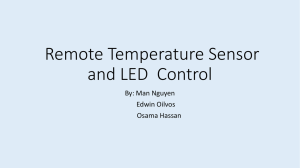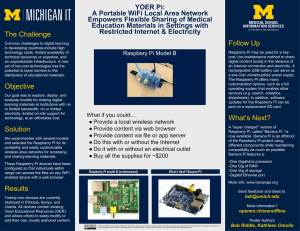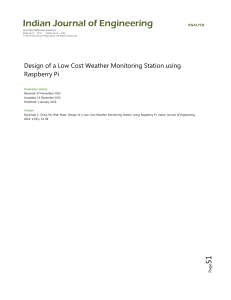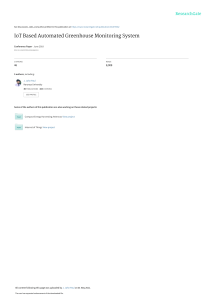Data acquisition is the process of gathering information on a... by acquiring data on one or more variables. An example... CHAPTER 1
advertisement
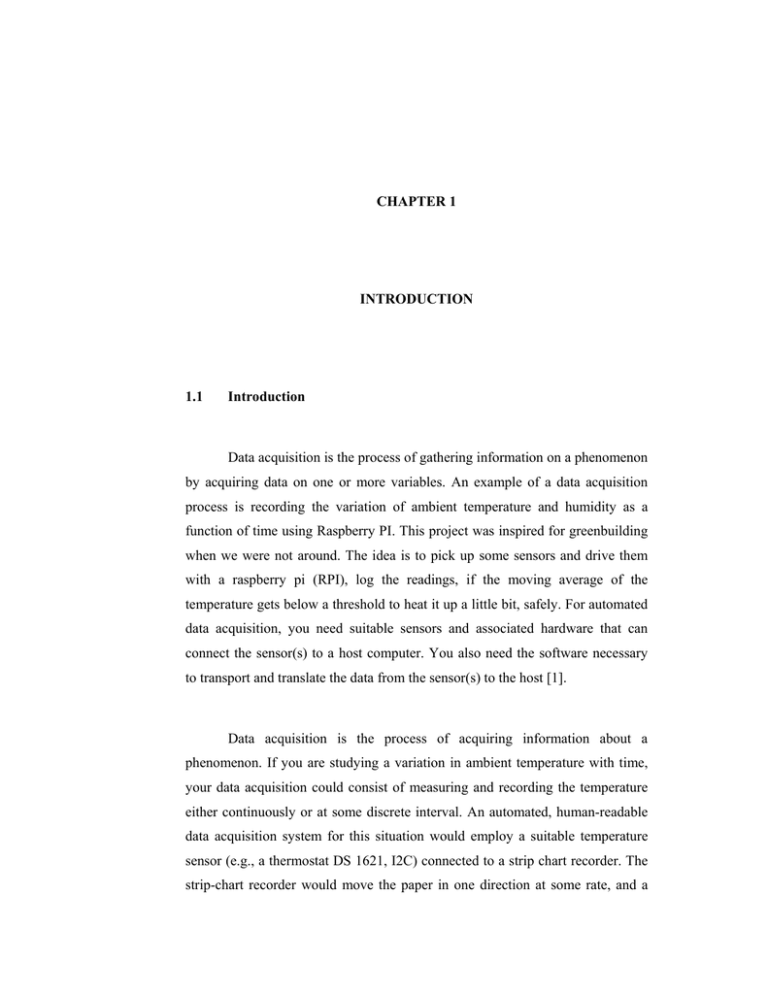
CHAPTER 1 INTRODUCTION 1.1 Introduction Data acquisition is the process of gathering information on a phenomenon by acquiring data on one or more variables. An example of a data acquisition process is recording the variation of ambient temperature and humidity as a function of time using Raspberry PI. This project was inspired for greenbuilding when we were not around. The idea is to pick up some sensors and drive them with a raspberry pi (RPI), log the readings, if the moving average of the temperature gets below a threshold to heat it up a little bit, safely. For automated data acquisition, you need suitable sensors and associated hardware that can connect the sensor(s) to a host computer. You also need the software necessary to transport and translate the data from the sensor(s) to the host [1]. Data acquisition is the process of acquiring information about a phenomenon. If you are studying a variation in ambient temperature with time, your data acquisition could consist of measuring and recording the temperature either continuously or at some discrete interval. An automated, human-readable data acquisition system for this situation would employ a suitable temperature sensor (e.g., a thermostat DS 1621, I2C) connected to a strip chart recorder. The strip-chart recorder would move the paper in one direction at some rate, and a stylus driven by the sensor output would plot the temperature in the orthogonal direction, thereby creating a continuous record of the temperature–time variation. A computerized solution for this scenario would essentially do the same thing, except that instead of writing the data to a strip-chart, the sensor and its associated components would transmit the data through some hardware interface to the PC. Suitable software package (Linux) can acquire, display, process, and store the data. The advantage of using a Raspberry PI for data acquisition is that a Raspberry PI has the flexibility to adapt to changing needs and to further process the resulting data to enhance its usefulness simple RPI assisted data acquisition system.Raspberry Pi is a credit-card sized board that runs Linux and has some useful headers for making stuff. My plan with this project was to use the GPIO headers of the RPi to read the DS1621s at regular intervals then log the readings into some kind of time series database .A polls the temperature readings every minute.. 1.2 problem statement This is a study based on an application that allows local and remote monitoring of a home temperature environment. It explores ways of employing an embedded operating system to implement an inexpensive home monitoring system consisting of sensors. As the sensors work together, they should at the same time, be able to give individual signals for each state that is being monitored in the area of application. The objective is to provide a monitoring system that would be capable of measuring temperature. Where necessary the system should be able to activate alarm circuits when operate out conditions then should also send a notification message to the person responsible. 1.3 Project Objectives The objectives and goals of this paper can be briefly summarized in the following points : To design the monitoring system where the temperature and humidity level automatically detects by the sensor system. To develop graphic user interfacing system (GUI) by using LINUX software to monitor the temperature and humidity level. provide a monitoring system that would be capable of measuring temperature and humidity. Where necessary the system should be able to activate alarm when operate out conditions then should also send a notification message to the responsible person. 1.4 Scope of study There are three points we considered them in this project: 1- A computer running a suitable software package (the data acquisition program) can acquire, display, process, and store the data. 2- The advantage of using a Raspberry PI for data acquisition is that a Raspberry PI has the flexibility to adapt the changing needs and its very cheap further process the resulting data to enhance its usefulness. 3- Determine the best results based on the highest accuracy and the time that consumed to build each model. 1.5 Organization of thesis At the beginning, chapter one shows an introduction on the necessary to understand the behaviour of the applications in the control the data by using Raspberry PI as a client. Also, it will include some characteristics about (RPI) application and why choose it as a client. Moreover, this chapter will contain the problem statement, the objective and the scope of this project. While in chapter two, the literature review of the thesis will be stated. First, after the introduction, it will talk about the Raspberry PI and what are the services which are provided by control the sensors. Also, it will include the (RPI) components.. Finally, at the end of this chapter we will show some related studies for remote control systems using (RPI). Chapter three will talk about the methodology of the research and how the thesis had been organized and how the data had collected . Chapter four will cover the results and the discussion of the results which had obtained by using LINUX software and GUI. Chapter five will talk about the conclusion of the thesis according to the result which had been obtained. Also, it will list the point that could be covered in future work for the other research.


